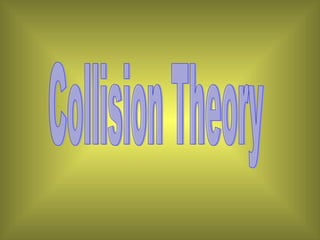Report
Share

Recommended
Recommended
More Related Content
What's hot
What's hot (20)
Lesson 1_Kinetic Molecular Theory of Solids and Liquids.pptx

Lesson 1_Kinetic Molecular Theory of Solids and Liquids.pptx
Properties of Compounds - Ionic, Covalent and Metallic

Properties of Compounds - Ionic, Covalent and Metallic
Similar to Collision theory
Similar to Collision theory (20)
7.COLLISION-THEORY-AND-CHEMICAL-REACTION-RATE.pptx

7.COLLISION-THEORY-AND-CHEMICAL-REACTION-RATE.pptx
More from beckydaw
More from beckydaw (20)
Recently uploaded
Recently uploaded (20)
Apidays New York 2024 - Passkeys: Developing APIs to enable passwordless auth...

Apidays New York 2024 - Passkeys: Developing APIs to enable passwordless auth...
EMPOWERMENT TECHNOLOGY GRADE 11 QUARTER 2 REVIEWER

EMPOWERMENT TECHNOLOGY GRADE 11 QUARTER 2 REVIEWER
Apidays New York 2024 - The value of a flexible API Management solution for O...

Apidays New York 2024 - The value of a flexible API Management solution for O...
ICT role in 21st century education and its challenges

ICT role in 21st century education and its challenges
TrustArc Webinar - Unlock the Power of AI-Driven Data Discovery

TrustArc Webinar - Unlock the Power of AI-Driven Data Discovery
Finding Java's Hidden Performance Traps @ DevoxxUK 2024

Finding Java's Hidden Performance Traps @ DevoxxUK 2024
Boost Fertility New Invention Ups Success Rates.pdf

Boost Fertility New Invention Ups Success Rates.pdf
Rising Above_ Dubai Floods and the Fortitude of Dubai International Airport.pdf

Rising Above_ Dubai Floods and the Fortitude of Dubai International Airport.pdf
AWS Community Day CPH - Three problems of Terraform

AWS Community Day CPH - Three problems of Terraform
Apidays New York 2024 - Accelerating FinTech Innovation by Vasa Krishnan, Fin...

Apidays New York 2024 - Accelerating FinTech Innovation by Vasa Krishnan, Fin...
2024: Domino Containers - The Next Step. News from the Domino Container commu...

2024: Domino Containers - The Next Step. News from the Domino Container commu...
Collision theory
- 2. For a reaction to occur two particles must collide
- 3. Not all collisions result in a reaction. If the particles don’t have enough energy they will bounce of each other
- 4. Reactions need a certain amount of energy to break old bonds so that new ones can be made. The minimum amount of energy needed is called the activation energy. Different reactions have different activation energies. Reaction between A requires 30Joules for its activation energy Reaction between B requires 50Joules of energy 15J 25J Which reaction will occur, A or B?
- 5. If we increase concentration, then there are more particles and therefore there are more likely to be more collision that are successful. If we double the concentration we double the rate because there are double the number of successful collisions. Low Concentration High Concentration
- 6. If we double the temperature the reaction rate will more than double. This is because the particles gain energy and move faster so there are more collisions. Also because the particles have more energy when they do collide they are more likely to react. A rise of 10 0 C doubles rate.
- 7. If there is more surface area there are more particles exposed and more collisions, so the rate of reaction increases.
- 8. A catalyst provides a different path for a reaction to take which requires less energy. This means that more collisions will be successful.